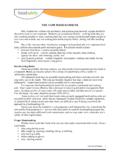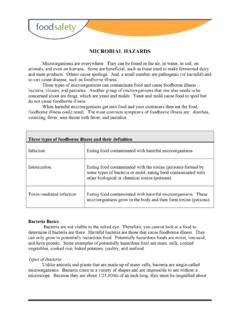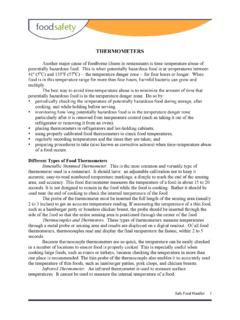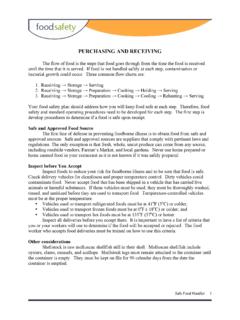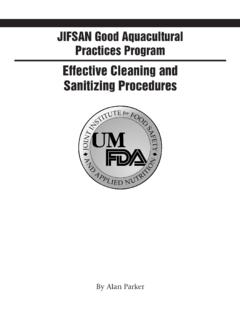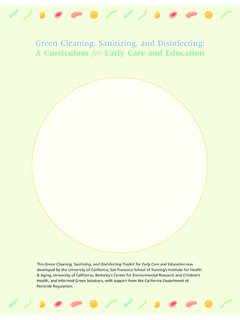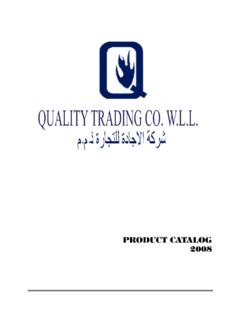Transcription of CLEANING AND SANITIZING - Food safety
1 CLEANING and SANITIZING 1 CLEANING AND SANITIZING CLEANING and SANITIZING procedures must be part of the standard operating procedures that make up your food safety program. Improperly cleaned and sanitized surfaces allow harmful microorganisms to be transferred from one food to other foods. CLEANING CLEANING is the process of removing food and other types of soil from a surface, such as a dish, glass, or cutting board. CLEANING is done with a CLEANING agent that removes food, soil, or other substances. The right CLEANING agent must be selected because not all CLEANING agents can be used on food-contact surfaces. (A food-contact surface is the surface of equipment or utensil that food normally comes into contact.)
2 For example, glass cleaners, some metal cleaners, and most bathroom cleaners cannot be used because they might leave an unsafe residue on the food-contact surface. The label should indicate if the product can be used on a food-contact surface. The right CLEANING agent must also be selected to make CLEANING easy. CLEANING agents are divided into four categories: Detergents Use detergents to routinely wash tableware, surfaces, and equipment. Detergents can penetrate soil quickly and soften it. Examples include dishwashing detergent and automatic dishwasher detergents. Solvent cleaners Use periodically on surfaces where grease has burned on. Solvent cleaners are often called degreasers. Acid cleaners -- Use periodically on mineral deposits and other soils that detergents cannot remove.
3 These cleaners are often used to remove scale in warewashing machines and steam tables. Abrasive cleaners -- Use these cleaners to remove heavy accumulations of soil that are difficult to remove with detergents. Some abrasive cleaners also disinfect. Clean food-contact surfaces that are used to prepare potentially hazardous foods as needed throughout the day but no less than every four hours. If they are not properly cleaned, food that comes into contact with these surfaces could become contaminated. SANITIZING SANITIZING is done using heat, radiation, or chemicals. Heat and chemicals are commonly used as a method for SANITIZING in a restaurant; radiation rarely is. The item to be sanitized must first be washed properly before it can be properly sanitized.
4 Some chemical sanitizers, such as chlorine and iodine, react with food and soil and so will be less effective on a surface that has not been properly cleaned. CLEANING and SANITIZING 2 SANITIZING Methods Heat. There are three methods of using heat to sanitize surfaces steam, hot water, and hot air. Hot water is the most common method used in restaurants. If hot water is used in the third compartment of a three-compartment sink, it must be at least 171oF (77oC). If a high-temperature warewashing machine is used to sanitize cleaned dishes, the final SANITIZING rinse must be at least 180oF (82oC). For stationary rack, single temperature machines, it must be at least 165oF (74oC). Cleaned items must be exposed to these temperatures for at least 30 seconds.
5 Chemicals. Chemicals that are approved sanitizers are chlorine, iodine, and quaternary ammonium. Chemical Sanitizers Different factors influence the effectiveness of chemical sanitizers. The three factors that must be considered are: Concentration -- The presence of too little sanitizer will result in an inadequate reduction of harmful microorganisms. Too much can be toxic. Temperature -- Generally chemical sanitizers work best in water that is between 55oF (13oC) and 120oF (49oC). Contact time -- In order for the sanitizer to kill harmful microorganisms, the cleaned item must be in contact with the sanitizer (either heat or approved chemical) for the recommended length of time. Sanitizer Testing Every restaurant must have the appropriate testing kit to measure chemical sanitizer concentrations.
6 To accurately test the strength of a SANITIZING solution, one must first determine which chemical is being used -- chlorine, iodine, or quaternary ammonium. Test kits are not interchangeable so check with your chemical supplier to be certain that you are using the correct kit. The appropriate test kit must then be used throughout the day to measure chemical sanitizer concentrations. CLEANING and SANITIZING 3 Advantages and Disadvantages of Different Chemical Sanitizers Chemical Concentration Contact Time Advantage Disadvantage Chlorine 50 ppm in water between 75 and 100oF 7 seconds Effective on a wide variety of bacteria; highly effective; not affected by hard water; generally inexpensive Corrosive, irritating to the skin, effectiveness decreases with increasing pH of solution; deteriorates during storage and when exposed to light; dissipates rapidly; loses activity in the presence of organic matter Iodine ppm in water that is at least 75oF 30 seconds Forms brown color that indicates strength; not affected by hard water.
7 Less irritating to the skin than is chlorine; and activity not lost rapidly in the presence of organic matter. Effectiveness decreases greatly with an increase in pH (most active at pH ; very low acting at pH ); should not be used in water that is at 120oF or hotter; and might discolor equipment and surfaces. Quaternary Ammonium Compouds U to 200 ppm in water that is at least 75oF 30 seconds Nontoxic, odorless, colorless, noncorrosive, nonirritating; stable to heat and relatively stable in the presence of organic matter; active over a wide pH range Slow destruction of some microorganisms; not compatible with some detergents and hard water CLEANING and SANITIZING 4 Machine Warewashing Most tableware, utensils, and other equipment can be cleaned and sanitized in a warewashing machine.
8 Warewashing machines sanitize by using either hot water or a chemical SANITIZING solution. Check the machine for cleanliness at least once a day. Make sure all detergent and sanitizer dispensers are properly filled. Scrape, rinse, or soak items before loading them into the machine. Load racks correctly and use racks designed for the items being washed. Check temperatures and pressure at least once a day. Check each rack as it comes out of the machine for soiled items. Air-dry all items. Keep your warewashing machine in good repair. High-Temperature Machines The temperature of the final SANITIZING rinse must be at least 180oF (82oC). For stationary rack, single temperature machines, it must be at least 165oF (74oC).
9 The machine must have a thermometer installed to measure the temperature of water at the manifold, where it sprays into the tank. Chemical- SANITIZING Machines Chemical SANITIZING machines often wash at much lower temperatures, but not lower than 120oF (49oC). Rinse water temperature in these machines should be between 75oF and 120oF (24oC and 49oC) for the sanitizer to be effective. CLEANING and SANITIZING in a Three-Compartment Sink 1. Rinse, scrape, or soak all items before washing them in a three-compartment sink. 2. Wash items in the first sink in a detergent solution that is at least 110oF (43oC). 3. Immerse or spray rinse items in the second sink using water that is at least 110oF (43oC). 4. Immerse items in the third sink in hot water or a properly prepared chemical SANITIZING solution.
10 5. Air-dry all cleaned and sanitized items before storing them. CLEANING In Place Equipment 1. Turn off and unplug equipment before CLEANING . 2. Remove food and soil from under and around equipment. 3. Remove detachable parts and manually wash, rinse, and sanitize them or run through a warewashing machine. 4. Wash and rinse all other food-contact surfaces that you cannot remove, then wipe or spray them with a properly prepared chemical SANITIZING solution. 5. Keep cloths used for food-contact and non-food-contact surfaces in separate properly marked containers of SANITIZING solution. 6. Air-dry all parts, then reassemble. 7. Resanitize food-contact surfaces handled during reassembly. CLEANING and SANITIZING 5 Storing Utensils, Tableware, and Equipment Improperly storing cleaned and sanitized equipment, utensils, and linens could allow them to become contaminated before they are used again.
